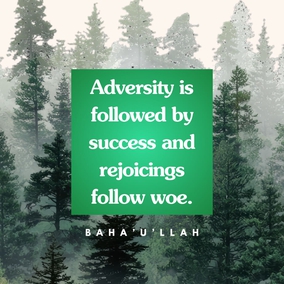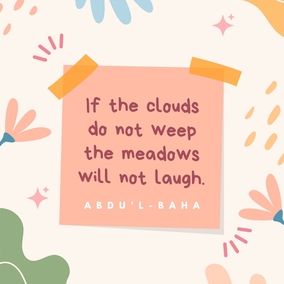The views expressed in our content reflect individual perspectives and do not represent the authoritative views of the Baha'i Faith.
Many mystics, prophets and holy messengers have said that the human soul traverses four progressive stages in its quest for spiritual development.
Psychologists and those who study education and human development agree: at least four specific stages are required for human maturation. Some call those stages pre-awareness, awareness, commitment and union; or simplicity, complexity, perplexity, and harmony. Some relate them to infancy, childhood, adolescence and adulthood. Theravada Buddhists connect the four stages of life with the maturational and spiritual path mapped out by the Buddha’s “four noble truths”—suffering, the causes of suffering, the cessation of suffering and nirvana. In Hinduism, the four ashramas—student, householder, hermit and ascetic—stand for the spiritual path every devout Hindu should ideally take.
For Baha’is, that four-stage pattern of spiritual growth appears in Baha’u’llah’s book The Four Valleys. In the closing pages of his mystical treatise The Seven Valleys, Baha’u’llah wrote that “the heart is endowed with four stages, which would be recounted should a kindred soul be found.” – p. 41.
In The Four Valleys, which the prophet and founder of the Baha’i Faith subsequently wrote about the four stages of the heart and addressed to a Sufi mystic and friend named Shaykh Abdu’r-Rahman, Baha’u’llah outlines the mysteries of our inner search for growth and the path we take to get there. Writing in beautifully poetic and mystical terms, Baha’u’llah gives every spiritual seeker a guide to growth with The Four Valleys, by drawing a map of the archetypal human spiritual journey, detailing the four stages in the progress of the soul, and helping humanity find its way on the seeker’s path.
To understand this remarkable book and its deeply mystical language, symbols and allusions, a little background may be helpful.
By the time he wrote The Four Valleys, Baha’u’llah had already suffered imprisonment, torture and exile. Not yet forty years old, his nascent Faith horribly persecuted, his family impoverished prisoners, his predecessor The Bab recently executed by firing squad, Baha’u’llah—like Abraham, Moses, Christ, Buddha and Muhammad before him—voluntarily left civilization behind in the spring of 1854 for a solitary sojourn in the wilderness.
He journeyed, on foot and in the humble garb of a poor traveler, with nothing but a change of clothes and an alms-bowl called a kashkul, to the uninhabited mountains of Iraqi Kurdistan. The kashkul, carried by poor dervishes, symbolized the traveler’s journey on the ocean of mystic knowledge.
In his austere, self-imposed exile, Baha’u’llah lived alone for some time on a remote mountain named Sar-Galu, sleeping in a stone hut or in a cave. He spent his time in seclusion, prayer, meditation and reflection for two years, suffering and struggling to unburden his soul and come to terms with the mission revealed to him two years before in the Black Pit of Tehran:
I roamed the wilderness of resignation, traveling in such wise that in My exile every eye wept sore over Me, and all created things shed tears of blood because of My anguish. The birds of the air were My companions and the beasts of the field My associates. – quoted in Shoghi Effendi’s, God Passes By, p. 120.
Despite the hunger, the silence, the loneliness, the abject poverty and the privations of Baha’u’llah’s wilderness sojourn, he later wrote that the period of voluntary isolation brought him pain, anguish, and blissful joy:
We betook Ourselves to the wilderness, and there, separated and alone, led for two years a life of complete solitude. From Our eyes there rained tears of anguish, and in Our bleeding heart there surged an ocean of agonizing pain. Many a night We had no food for sustenance, and many a day Our body found no rest. By Him Who hath My being between His hands! Notwithstanding these showers of afflictions and unceasing calamities, Our soul was wrapt in blissful joy, and Our whole being evinced an ineffable gladness. For in Our solitude We were unaware of the harm or benefit, the health or ailment, of any soul. Alone, We communed with Our spirit, oblivious of the world and all that is therein. – Baha’u’llah, The Book of Certitude, p. 250.
During that period of solitude, Baha’u’llah’s joy and gladness began to emerge in odes, prayers, poems, soliloquies and prose. Called “the first fruits of his divine pen” by Shoghi Effendi, the Guardian of the Baha’i Faith, these insightful, revelatory writings emerged as his earliest works, compositions of deep mystical symbolism and striking, inspirational beauty:
The denizens of this plane speak no words—but they gallop their chargers. They see but the inner reality of the Beloved. To them all words of sense are meaningless, and senseless words are full of meaning… To them the mirage is the real river… – Baha’u’llah, The Four Valleys, p. 55.
Some of those early, lofty writings eventually found their way into the hands of the people of the region, which brought Baha’u’llah to the attention of the leading Sufi mystics there.
When that happened, Baha’u’llah met Shaykh Abdu’r-Rahman, became good friends with the Sufi leader, and eventually wrote him a long letter in the classical Persian epistolary style, complete with quotations from the Qur’an, philosophers like Avicenna and poets like Rumi and Sa’di. That extended letter later became a short book called The Seeker’s Path, now re-titled The Four Valleys—which forms one of the foundational mystical pillars of the Baha’i revelation.
In the next essay in this series, we’ll take a closer look at The Four Valleys, explore its relationship to poets and mystics like Rumi, and begin trying to understand what it tells us about our souls.
















Comments
Sign in or create an account
Continue with Googleor